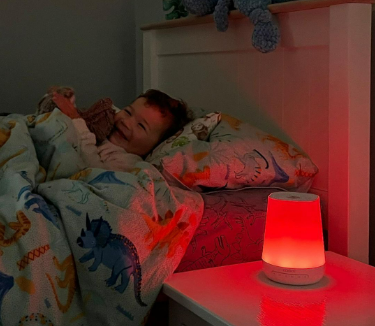Moving Your Toddler to The Big Bed
- Babee Dreams
- May 15
- 5 min read
Updated: Jun 25
Making the transition from a cot to a big bed is a major change for both you and your toddler. While it can be tempting to make the switch early (especially when sleep is rocky or there’s a new baby on the way), timing it right is key to a smooth transition and better sleep outcomes in the long run.
Let’s unpack when your toddler might be ready for a big bed and how to make the transition easier.
When is the right time to transition to a toddler bed?
If they’re not climbing out, they're safe, snug, and likely comforted by the confined space. If it’s not causing any issues and they’re not asking for the change, then there’s no need to rush it. Just leave them be.
The general rule of thumb? Wait until at least 3 years old (2.5 years old minimum).
Why? Because toddlers younger than that often don’t have the developmental maturity to understand bedtime boundaries like “stay in bed.” If you move them too soon, you may find yourself dealing with more sleep issues, not fewer. But as always, every child is different. These signs can help you determine if they’re ready:
They’re climbing out of the cot: Safety first. If your toddler is a little escape artist, it might be time. For more advice on this, read my blog "Is your toddler frequently getting out of bed?".
They’ve physically outgrown the cot: If they’re too tall, heavy, or cramped, the cot may no longer be suitable.
They’re asking for a bed: If your toddler starts requesting a "big kid bed," that’s a good sign of developmental readiness.
If your toddler is under 2.5 but already climbing out, try these cot-hacks:
Lower the mattress all the way to the floor (so the rails are higher relative to their body).
Use a sleeping bag to reduce mobility. This can delay the transition and keep them safer.
What not to do, just because…
You’re expecting a new baby
It’s common to want the cot back, but if your toddler isn’t ready, early transition can lead to poor sleep habits. Instead, use a bassinet for the newborn or borrow a second cot temporarily, if space allows. It's also possible to have two cots in one room.
They’re having sleep issues If sleep has taken a turn, it’s rarely solved by switching to a bed. In fact, it can make things worse. Focus on fixing the sleep struggles first. I offer one-on-one support and downloadable sleep guides to help with any challenges your little one is facing.
Tips when doing this transition
Get them involved: Letting your toddler be part of the process can give them a sense of importance, which goes a long way in making the transition smoother. They can help pick out their new bedding or assist in setting up their new space. Any way you involve them will help build excitement and ease the change.
Keep the routine consistent: Stick to your same bedtime routine and schedule. Familiarity helps toddlers adjust to new sleep environments more easily. I have a free downloadable mini guide, Toddler Bedtime Routine Chart, that can make bedtime fun and easier. It’s packed with helpful tips and includes a printable bedtime chart.
Set boundaries (and stick to them): Once your child is in a bed they can freely get out of, it’s crucial to reinforce sleep boundaries. This is where a reward system or an “OK-to-wake” light can be helpful. Prepare the room accordingly: With the freedom that comes from moving to a bed, your toddler may explore more than ever, especially during those early days of transition. It's essential to make their room as safe as possible, almost like turning it into a giant cot.
Here’s what to check:
Secure heavy furniture and anchor tall or unstable furniture to the wall to prevent tipping if your toddler tries to climb.
Cover all power points. Use outlet covers to keep curious little fingers safe.
Reassess the decor you have, move higher or remove any items that are now within reach, especially breakables, sharp objects, or anything with small parts.
Make sure blinds don’t have loose or dangling cords. Use cord winders or cut cords short to prevent choking hazards.
Ensure they cannot leave the room. This is a huge safety risk if everyone is asleep and they wander in the night. Consider a child-proof doorknob cover, a gate, or even a door alarm to alert you.
Pick the right time: Try to make the move when everything else in their world feels stable. Avoid transitioning to a big bed during other major changes, like starting daycare, beginning potty training, welcoming a new sibling, or moving house. Too many changes at once can feel overwhelming and may lead to more issues.
Give them the best chance for success by choosing the right time.
Should you introduce a pillow?
The safest time to offer a pillow is when:
They’ve transitioned into a toddler bed
They’re developmentally ready (typically 2.5–3 years old)
Here’s what to consider:
Start with naps: Observe how they use the pillow during a short, supervised sleep before trying it overnight.
Watch for unsafe use: If they squish their face into it or pull it over themselves, they may not ready.
Choose the right kind: Go for a small, flat, firm pillow — perfect for developing necks and spines. Big, fluffy pillows can be unsafe. Many baby and bedding stores have speicfic pillows for toddlers.
The bottom line
Transitioning to a toddler bed is a major step, one that should be based on readiness, not pressure. Rushing into it too soon can make sleep even harder, but waiting until your child is truly ready can lead to a smooth, exciting, and positive experience.
Struggling with sleep, even before the transition?
Having a solid sleep foundation can often help babies and toddlers navigate changes more seamlessly, with minimal or no noticeable effects on their sleep.
I offer various resources, such as sleep guides and one-on-one options like sleep plans and phone consultations. We've helped over 300 families in similar situations and if you think you could benefit from additional support during this time, I have the perfect resource: the "4-24 Month Sleep Guide." This guide is filled with solutions to help with.
If you feel you might need more personalised support, I offer phone consults, and one-on-one support through plans. These services allow us to work closely together and address your specific needs.

I'm the founder of Babee Dreams, a certified sleep consultant, and a mum of three. Everything I share is from evidence-based research, professional training through The Sleep Consulting Academy, real-life success stories from families I've worked with, and the instincts that come from being a mum.
Disclaimer: This blog is for informational purposes only and is not a substitute for professional medical advice. Always consult your healthcare provider for personalised guidance regarding your baby's health and well-being, Babee Dreams does not give medical advice.



